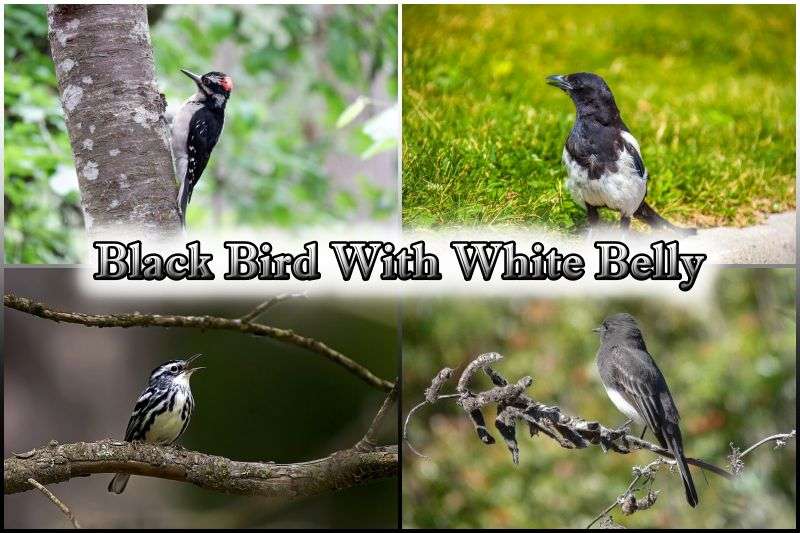We see various types of birds in our day-to-day lives, but we don’t identify most of them. We may have seen some beautiful black and white birds but are unable to differentiate between them. This article is a visual guide to identifying black and white birds that are present in your surroundings.
Black and white colors, when present together in a bird, look clean and minimalist as well as bold and striking. These colors together form different patterns on different species and make birds edgy.
If you want to admire these beautiful small black birds with white bellies, you have come to the right place.
Below is a list of 15 small black birds with white belly. Some additional information about them is also mentioned along with their pictures so that you can educate yourself about them.
15 Small Black Birds With White Belly
1) Loggerhead Shrike
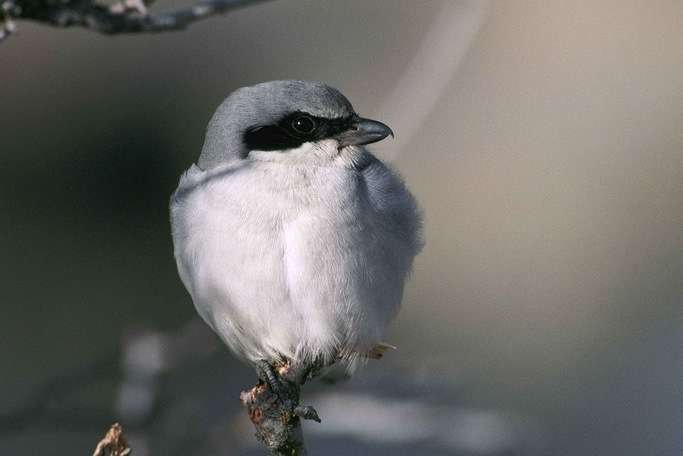
First on the list is a medium-sized passerine bird, the Loggerhead shrike, which is known as the “Butcher Bird.” It is called so because of the way it impales its prey on any sharp object, such as a fence or thorn, and tears it into smaller pieces to store for later; this also helps in the release of any toxin that might be present in the food.
They have comparatively larger heads than the rest of their bodies. These birds are black and grayish-white, with entirely white bellies.
The black color can be seen on the ear patch, the wingtips, and the uppertails. Their beak and legs are also black, whereas the throat, breast, belly, and undertail coverts are white with tiny black eyes.
It inhabits open areas with elevated perching and nesting sites and resides in open pastures or grasslands with sparse vegetation that helps it look out for prey more efficiently.
Red-cedar and hawthorn trees are their preferred trees for dwelling because their thorns and pin-like needles protect them from potential predators.
They feed primarily on monarch butterflies and toads, but they also eat small mammals, birds, and small snakes.
- Scientific name: Lanius ludovicianus
- Size: 7.9–9.1 inches (20–23 cm)
- Location: North America
2) Black-and-White Warbler

The black-and-white warbler, the only member of the genus Mniotilta, is the Least Concern species on the IUCN list because of its large population size.
They have a beautiful black and white striped pattern all over their dorsal side. The alternating black and white lines cover their head, back, rump, and side coverts, and they have a white color on their chin, throat, and belly.
The black and white warbler is known for its warbling or singing; they sing with trills and quavers. It has two pitched calls a hard tick and a soft, thin fsss.
Males also sing to defend their territories and chase away competitors. They have good acrobatic skills and fascinate females by displaying their wings.
They inhabit deciduous and mixed forests and are sometimes found in swampy areas. These birds make cup-shaped nests on the grounds of the forests; their nests could be found at the base of a tree, on a log stump, or in the leaf litter of the forest.
Their diet consists of lepidopteran larvae, insects, spiders, and other arthropods. They resemble nuthatches in foraging on tree trunks and moving up and down on tree trunks and inner branches.
- Scientific name: Mniotilta varia
- Size: 11-13 cm (4.3-1.5 inches)
- Location: northern and eastern North America
3) Blackpoll Warbler
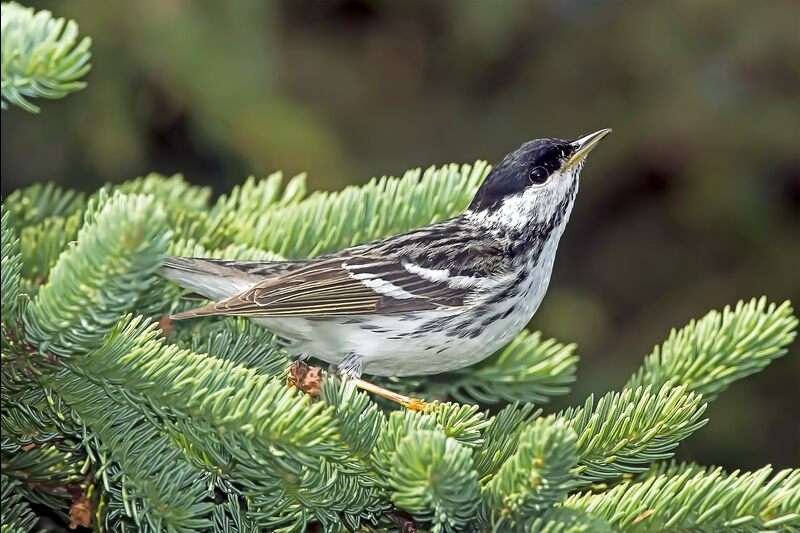
The blackpoll warbler is different from the black-and-white warbler in having a black color crown and white cheeks. This bird holds the record for the longest over-water flight. They are songbirds but have a very high-pitched voice, which is almost unbearable.
The male differs from the females in having a solid black cap, whereas the females look like a dull and washed-out version of the male. Males and females are visually distinguishable.
They are petite birds with shorter tails but have longer wings compared to other warblers.
They have a short, grey-colored bill. Their dorsal sides have brownish-black streaks with two white wing bars, and they have black color streaks on the underparts. Their cheeks, throat, and belly are whitish.
They inhabit mountains in woodlands or bushy areas. These birds perch in dense foliage and have a relatively inactive foraging style; therefore, they are more often heard than seen.
They are insectivorous birds and feed on insects, spiders, and sawfish. They even eat berries during migration.
- Scientific name: Setophaga striata
- Size: 12.5 to 15 cm (4.9 to 5.9 inches)
- Location: northern North America and the northeastern coast of South America
4) Snow Bunting
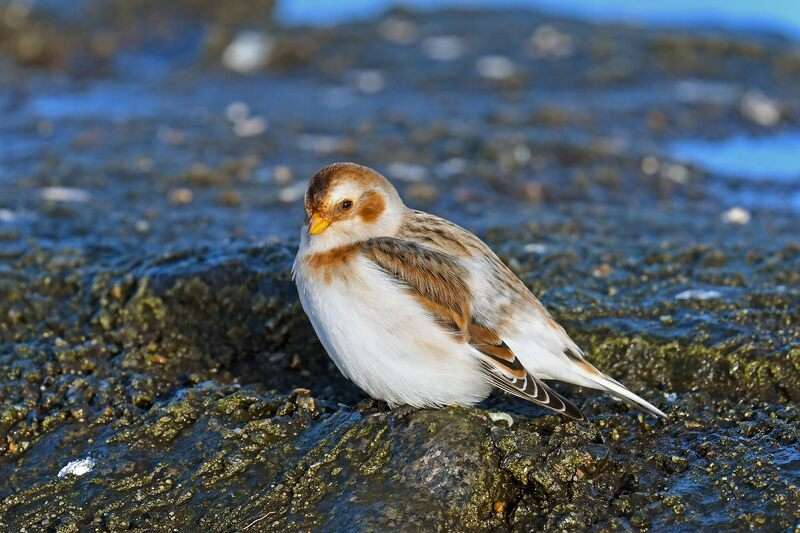
The Snow Bunting is a passerine bird that is considered an Arctic specialist. They are found in the arctic tundra, where they breed among rocky crevices, but in the winters, they migrate to farms, open barren fields, and lake shores to feed on seeds in open grounds. Whatever the case, they are never far from the snow.
These birds have snow-white plumage with a yellow color bill. Their wingtips are black, and they have black and white tails. They also have rusty-copper color markings on their breast and face.
Their crisp white coloration helps them camouflage themselves with the arctic snow. Their back is brownish or blackish, depending on the weather conditions.
They are ground-dwelling birds that feed on fallen fruits and seeds on the ground. They also consume insects and spiders.
- Scientific name: Plectrophenax nivalis
- Size: 15 cm
- Location: Arctic Tundra
5) Northern Mockingbird

The Northern Mockingbirds are known for their intelligence and mimicking ability; they copy the various sounds of sirens, other birds, crickets, etc.
They do so to show off their rivals because the more calls a mockingbird makes, the more preference it can get from females over other potential mates.
These birds have a grayish-black back and shiny black wings with white patches that are primarily visible during flights. The upper tail is black and white, whereas they have completely white underparts. Juveniles have black spots on their breasts and bellies and black and white streaks on the back.
The mockingbird inhabits open areas with sparse vegetation. They also dwell in suburban and urban areas such as parks and gardens, as well as in residential areas.
They also love to reside on mowed lawns with shrubs within proximity for shade and nesting. These birds don’t nest in densely forested areas.
These birds are omnivores and eat arthropods, earthworms, berries, fruits, and seeds. They also consume lizards occasionally.
- Scientific name: Mimus polyglottos
- Size: 20.5 to 28 cm (8.1 to 11.0 inches)
- Location: North America
6) Black-Capped Chickadee

The Black-Capped Chickadee is a small, perching bird. It is North America’s songbird, which is famous for its good spatial memory, which it uses to relocate its food and also for its capability to minimize its body temperature during cold weather. It is a very human-friendly bird.
As its name suggests, it has a strong black color on the head; the throat and nape are also black. Its plumage is white and black with a grayish-black tail, and it has rusty brown sides and white underparts.
These birds inhabit deciduous and mixed forests with dense vegetation of willow thickets, groves, and shaded trees. They avoid living in purely coniferous forests.
Their diet consists of insects. These birds hover on tree branches in search of food and may make short flights to catch insects in the air. In the winter, they prefer eating seeds and berries along with insects, eggs, and pupae.
They cache food items such as seeds and insects like other members of the family Paridae. Their foraging behavior freezes in the winter due to the changing weather, and they search for food less frequently.
- Scientific name: Poecile atricapillus
- Size: 12–15 cm (4.7–5.9 inches)
- Location: North America
7) Carolina Chickadee
This is the second chickadee on this list after the black-capped chickadee. These two species come together to make hybrid babies that sing songs associated with both species. If you want to attract a pair of these birds, put up a nest box in your backyard; they don’t mind a little mess.
Carolina chickadees differ in appearance from black-capped chickadees in having a whitish-grey nape and upper back. They have short wings and tails, just like the black ones.
These birds have slightly brownish hues on their upper plumage and somewhat less noticeable white color fringing on secondaries. They have dull and rusty flanks with a whitish belly. They also have a small, black-colored bill similar to that of black chickadees.
These mainly inhabit deciduous forests, swamps, basins, and pine woods that have a good mixture of oak and other leafy trees and nest in well-stumped suburbs.
Their diet consists mainly of insects, seeds, and berries. They also feast upon caterpillars, spiders, and small fruits.
- Scientific name: Poecile carolinensis
- Size: 11.5–13 cm (4.5–5.1 in).
- Location: New Jersey, Florida, Kansas, and Texas in the United States
8) Dark-eyed Junco

Next on the list is the Junco, a small bird with a white belly. Their subspecies are divided into different groups based on authority and color patterns.
The different groups are; Oregon or brown-backed group, Pink-sided group, Gray-headed group, Red-backed group, and the Stale-colored group.
They can be visually identified by a tiny, short bill and a large tail in comparison to the rest of their bodies. They have a stale-colored back with a darker black head.
The face, neck, breast, and upper dorsal parts are grayish. Their bellies and undertail coverts are completely crisp white.
Dark-eyed Junco inhabits wooded habitats with bushy thickets and weed fields and forages on the grounds for seeds in flocks. They feast mainly upon the seeds of weeds and grasses. Their diet also consists of insects, spiders, and some berries.
- Scientific name: Junco hyemalis
- Size: 13 to 17.5 cm (5.1 to 6.9 in)
- Location: North America and the Arctic during migration
9) American Oystercatcher
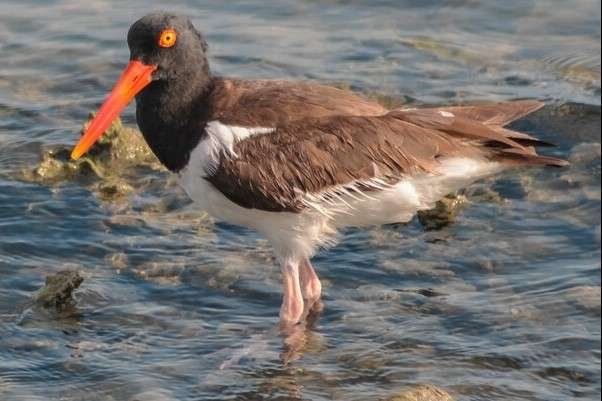
American Oystercatchers are also called American Pied Oystercatchers because they catch oysters by stabbing their long, flat bill into the shell, opening it by severing the muscles that hold the shell together, and feeding on it.
They have quite distinctive eyes, a bright orange color bill, and their back plumage is darker brown to black color, with a solid black color head, face, and neck.
They have a white color breast, belly, and undertail coverts. These birds inhabit intertidal areas and their adjacent beaches.
American oystercatchers mainly consume saltwater mollusks, including species of clams, several oysters, and mussels. They occasionally feed on jellyfish, starfish, sea urchins, marine worms, and crustaceans.
- Scientific name: Haematopus palliatus
- Size: 42–52 cm (17–20 in)
- Location: Atlantic Coast of North America, Gulf Coast, and Pacific Coast of South America
10) Pied Kingfisher
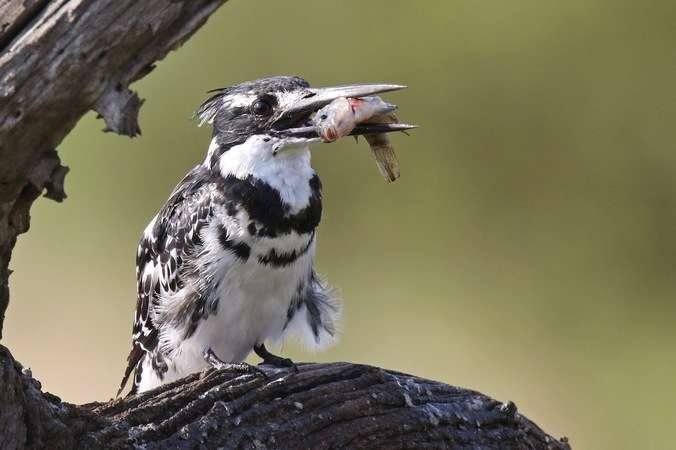
The Pied Kingfisher is a small black and white bird with a distinctive crested crown. It has white colored wings with black wing tips.
Pied Kingfisher has a white face with black eye lines, and its nape, throat, and back are black. When they fly, their white undertail with black lines looks very astonishing.
These birds dwell in a wide range of riverside habitats, such as lakes, estuaries, and mangroves. Their diet consists of fish, but they also feast on crustaceans and aquatic insects. They hover over water and dive vertically to catch prey with their large, dagger-like bill.
- Scientific name: Ceryle rudis
- Size: 25 cm (9.8 inches).
- Location: Africa and Asia
11) Ladder-backed Woodpecker

Ladder-Backed Woodpecker is a tiny bird with a rigid, inflexible tail that supports them when they lean against surfaces. Their square-shaped heads have a bright orange to the red color crown.
Their hump and back look striped in black and white while they are sitting, but during flight, their wings look black with circular white spots.
The ladder-backed woodpecker inhabits dry, brushy habitats, such as deserts, desert scrubs, thorn forests, and pinyon-juniper woodlands.
Their diet consists of insect larvae and insects. Occasionally, they don’t mind eating cactus fruit.
- Scientific name: Dryobates scalaris
- Size: 16.5-19 cm (6.5-7.5 inches)
- Location: North America
12) Royal Tern
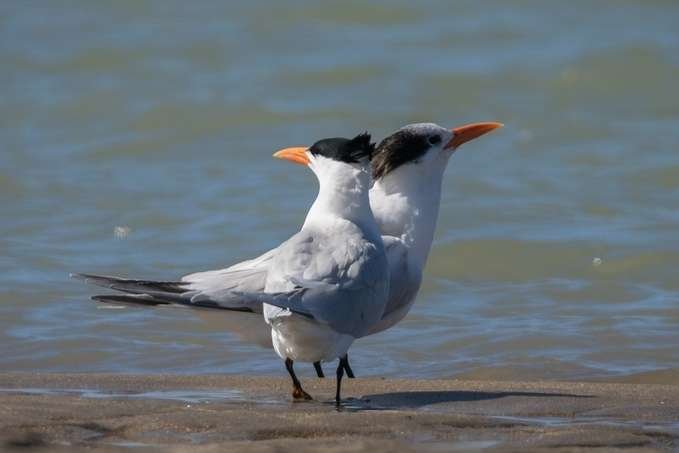
The royal tern is a seabird that belongs to the family Laridae. Their shiny white plumage is eye-captivating. They have a dark black colored crown and head.
They have a lighter gray-colored back and hump, and their uppertail is also grayish. Some have black wingtips, while others have grey ones. The color pattern is gradual, from black to grey and grey to white. They have an orange bill and a forked tail.
These birds live near warm coastal marine waters and only migrate to saltwater bays and rivers when they’ve to feed their young. They usually forage near shore and feed on fish and crabs.
- Scientific name: Thalasseus maximus
- Size: 45–50 cm (18–20 inches)
- Location: Coastal America
13) Black Phoebe

The Black Phoebe is a passerine flycatcher but migrates less than any other bird of its genus. It is a small black bird with a white belly, undertail coverts, and an orange-colored mouth.
These birds dwell in the open on low perches to find insects. They live in a cup-shaped nest, which they build against walls and bridges.
They reside near water bodies in shady streams, walled canyons, farmyards, and towns. Their diet consists of a wide variety of insects and small fish.
- Scientific name: Sayornis nigricans
- Size: 16 cm (6.3 inches)
- Location: West and Southwest United States
14) Rose-Breasted Grosbeak
The Rose-Breasted Grosbeak is also called “cut throat” because of its intense, contrasting coloration. A blood-red colored triangular patch is on a white chest just below their neck, which looks like blood pouring out of a cut neck.
Their face, head, back, nape, and upper tail are entirely black, with white patches on their wings. Their bellies and undertail are white and have a white, stout bill.
They are known for their beautiful, melodic songs. These birds are found in deciduous woods, orchards, and groves and feed on insects, seeds, and berries.
- Scientific name: Pheucticus ludovicianus
- Size: 18–22 cm (7.1–8.7 inches)
- Location: Eastern North America, tropical North America
15) Black-billed Magpie
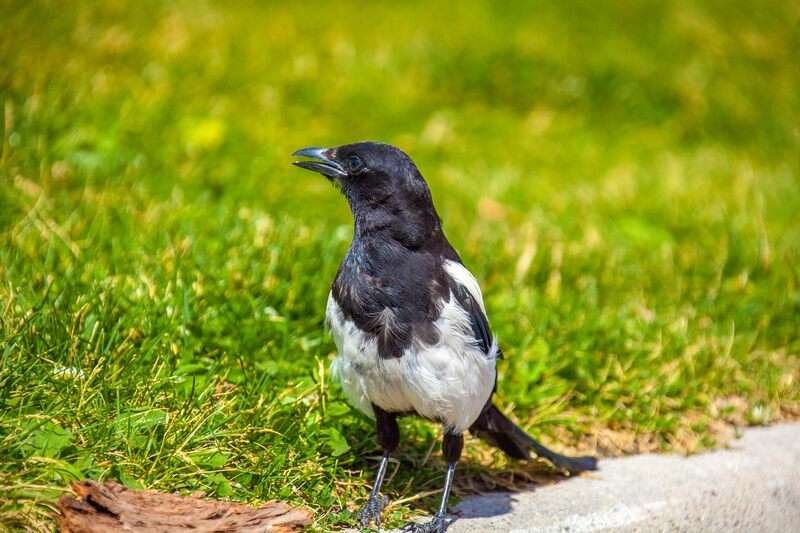
Lastly, we have a crow on this list, the Black-billed Magpie, which is known for its aggressive behavior.
Though these birds are friendly and social for most of the year, sometimes, in order to defend their territory and protect their young, they attack other animals, including humans. These attacks are dangerous and terrifying, especially for children.
These birds have lustrous plumage that glimmers with a blue, green, or purple shine. They have black wings with white wingtips and milky white flanks. Their bellies are crisp white and have a dark, heavy beak.
The black-billed magpie dwells in meadows, grasslands, farmlands, woodlands, hedgerows, and on the edges of dense forests, and their diet includes insects, rodents, eggs, and small snakes.
- Scientific name: Pica hudsonia
- Size: 45–60 cm (18–24 inches)
- Location: Western North America
Here, we conclude our article on “small black bird with white belly.” We hope you like the post. We will be back with another article. Till then saty tuned with us and read the articles mentioned below.
Also Read:

Hey there! I’ve been the kid who used to love watching all the science stuff and that fascination lead me to choose Zoology as my Major in Graduation. I’m a self-taught writer and spend my time writing scintillating content on animals. I love observing animals behavior and their bond with humans. I want to give my point of view regarding animals i research about. I had done several projects on animals during my graduation and learned their behavior thoroughly.
